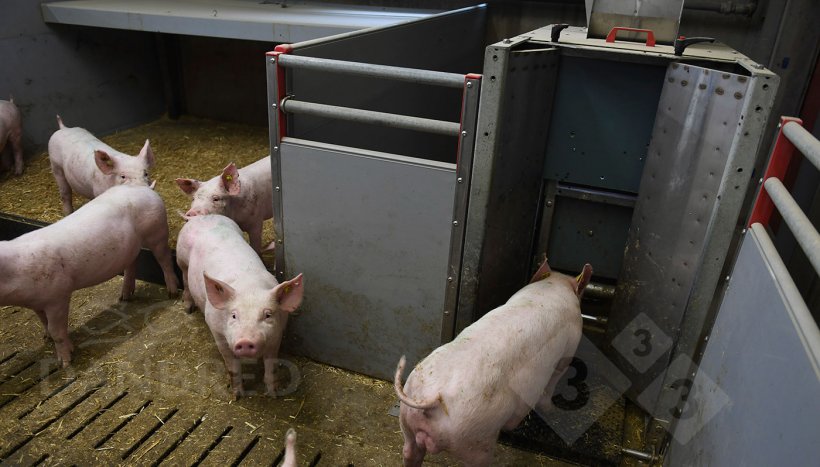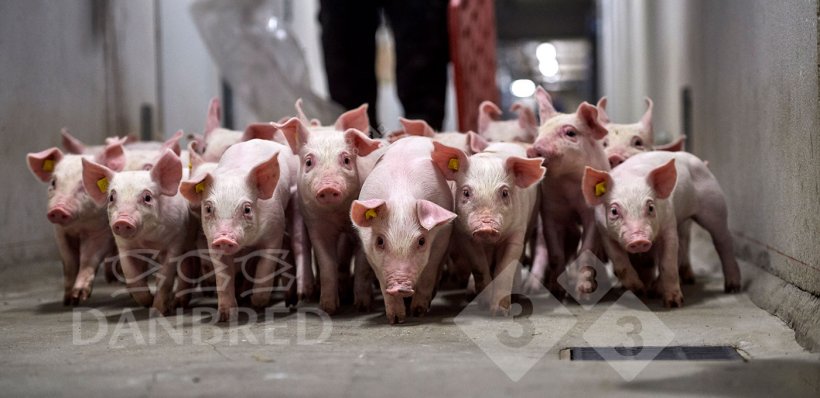DanBred started as a cooperative of Danish farmers more than one hundred years ago. Then in 2017, it became a company mainly focused on being a marketing organization devoted to sales. Research and development are under the responsibility of the Danish Agriculture & Food Council and the breeding is done by Danish farmers under contract.
The main objective of DanBred was, and still is, to provide the best genetics to maximize the genetic response for the Danish farmers. As commercial pig production is quite similar around the world, DanBred genetics are also exported globally.

Selection based on economics
The dam lines are DanBred Landrace and DanBred Yorkshire with a genetic nucleus of 8,000 to 10,000 females for each line.
The selection criteria are based on the traits that have an economic value, but the selection outcome also depends on how the different traits interact with one another.

Moving from LP5 to piglet survival
Historically, prolificacy has been a key characteristic when we speak about DanBred genetics, but the current objectives are more focused on improving piglet survival. The previous trait, the number of live piglets on day 5 after farrowing (LP5), was in fact a combination of Total Number Born (TNB) and Piglet Survival. The first decade of selection for LP5 resulted in both increased TNB and increased piglet survival. However, after 2016, the data showed that continued selection for LP5 led to an increase in TNB rather than improved survival. Therefore, in 2022, it was decided to change the selection criteria to consider TNB together with both components of survival:
- survival coming from the piglet itself
- survival coming from the maternal effect of its birth sow
Table 1. Percentwise distribution of economic genetic gain over robustness traits, slaughter traits, and reproduction traits over the years in the F1 cross between DanBred Landrace and DanBred Yorkshire. Until 2022, Live Piglets at day 5 after birth was part of the breeding goal, so there was no clean separation of robustness and reproduction traits.
| 2007 | ||
| Robustness | Reproduction | Slaughter traits |
| • Conformation • Longevity |
• Daily Gain (birth to 30 kg) • Daily Gain (30 kg to slaughter) • FCR • Carcass yield (%) • Lean % |
|
| • LP5 | ||
 |
 |
|
| 2011 | ||
| Robustness | Reproduction | Slaughter traits |
| • Conformation • Longevity |
• Daily Gain (birth to 30 kg) • Daily Gain (30 kg to slaughter) • FCR • Carcass yield (%) • Lean % |
|
| • LP5 | ||
 |
 |
|
| 2015 | ||
| Robustness | Reproduction | Slaughter traits |
| • Conformation • Longevity |
• Daily Gain (birth to 30 kg) • Daily Gain (30 kg to slaughter) • FCR • Carcass yield (%) • Lean % |
|
| • LP5 | ||
 |
 |
|
| 2018 | ||
| Robustness | Reproduction | Slaughter traits |
| • Conformation • Longevity |
• Maternal early gain | • Daily Gain (birth to 30 kg) • Daily Gain (30 kg to slaughter) • FCR • Carcass yield (%) • Lean % |
| • LP5 | ||
 |
 |
|
| 2022 | ||
| Robustness | Reproduction | Slaughter traits |
| • Conformation • Piglet survival • Longevity |
• Litter size (sow effect) | • Daily Gain (birth to 30 kg) • Daily Gain (30 kg to slaughter) • FCR • Carcass yield (%) • Lean % |
 |
 |
 |
| 2024 | ||
| Robustness | Reproduction | Slaughter traits |
| • Conformation • Piglet survival • Sow survival |
• Litter size (sow effect) | • Daily Gain (birth to 30 kg) • Daily Gain (30 kg to slaughter) • FCR • Carcass yield (%) • Lean % |
 |
 |
 |
Piglet survival is being influenced by a relatively large number of factors, but our program does not want to focus on specific single traits but rather on improving piglet survival as a final objective. For example, we know that bigger piglets have a higher chance of survival so you could think that selecting for heavier birth weight would be the solution. However, rather than focus on a single trait as could be individual piglet birth weight, our objective is to directly work on improving piglet survival rate. This improvement could come as an effect of improved birth weight but also better litter homogeneity or so many other factors such as higher robustness or vitality of the newborn piglets when looking for the udder or even some other factors affecting piglet survival rate that are yet unknown or very difficult to measure.
The same applies for the maternal effects affecting piglet survival. Number of teats is easy to record but there is not good evidence that selection for this trait will have a direct effect on the ability of the sow to take care of more piglets, so our program is focused on selecting for this ability - to take care of the piglets.
DanBred’s current objective regarding prolificacy, measured as Total Number Born, have a nearly flat genetic trend, meaning that TNB is stable or slightly increasing. However, the number of weaned piglets per litter is expected to increase through the improvement on piglet survival.

Sow survival
Around 2020 there were some indications of a global reduction in sow and piglet survival rate affecting different countries and different genetics. It is clear that robustness has an important economic impact and therefore changes have been made to achieve a more precise selection on sow longevity.
After 5 years of intensive research including a PhD project, on March 24, a new set of data to improve our ability to select for sow survival was introduced. Previously, the data used came from the multiplication herds. However, multiplication herds may cull sows that are fit and productive, purely based on index. Currently, we are instead considering the data from 100,000 crossbred sows located in production units where culling decisions are made mainly based on the ability of the sow to perform and not on her index.
Sow survival is not an easy trait to work with for many different reasons. It has low heritability as many other factors than genetics contribute to the robustness of a sow. Also, the genetic evaluation of crossbred sows generates different challenges as heterosis and other factors that add complexity to the evaluation of a trait need to be taken into account. The genetic evaluation system receives information from the time the sow enters the herd, but the older the sow, the more valuable her data. Therefore, it takes a lot of data to have good genetic evaluations for sow survival. Considering that we have a very high amount of sow records, we expect to be able to generate large genetic progress for sow survival.
After working with this new and improved set of data, sow survival has become the most important trait in the dam lines. The selection of our candidates is multitrait, as characteristics such as leg conformation and walking action have good correlation with survival.
Production traits are also considered in dam lines and had a very important role in previous dam line indexes, especially Feed Conversion Ratio, which still account for 16% of the economic genetic gain in the hybrid sow line.
Regarding meat quality, we keep looking at this trait, but it is difficult to give it an economic value considering that Danish farmers nowadays are not being paid for it and also meat quality standards are sometimes difficult to establish as the preferences of the different markets evolve regarding fat content, meat color, etc.
DanBred is also performing genotyping and it has shown to be very useful, allowing their genetic gain to increase by 30% after the implementation of genomic selection in 2010. All selection candidates (more than 125,000 animals per year) are genotyped and this information is included in all multitrait models. This means that the system does not look at a single marker but all of them simultaneously.
New traits are being considered but this is a complex procedure as all the potential correlations need to be analyzed before being implemented. Two of the most promising ones are litter weight gain and survival from weaning to slaughter age.
Litter weight gain as a mothering ability is a combination of the ability of the sow to keep her piglets alive and to produce milk to sustain their growth. To do so, all the first parity sows receive the same number of piglets. The litter is weighed at day 1 and no more piglets can be added, only removed if they are at risk. At day 21 the litter is weighed, and the piglets counted. When included in the breeding goal and selection index, we expect to increase the mothering ability of our sow lines.
The composition of DanBred genetic index for the dam lines has changed significantly in the last few years. This can be seen from the table of the makeup of genetic progress in the F1 cross between DanBred Landrace and DanBred Yorkshire. The constant update of our breeding goal and the focus on getting larger and improved sets of data help us to improve our genetic progress in the future.





